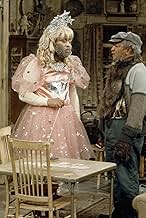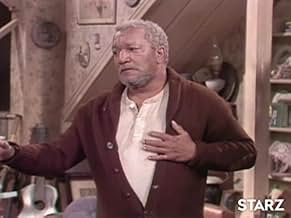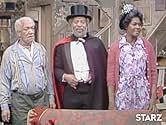As desventuras de um comerciante de sucata e de seu filho frustrado.As desventuras de um comerciante de sucata e de seu filho frustrado.As desventuras de um comerciante de sucata e de seu filho frustrado.
- Indicado para 7 Primetime Emmys
- 4 vitórias e 12 indicações no total
Explorar episódios
Avaliações em destaque
It's already known that `Sanford and Son' was the Americanized version of `Steptoe and Son' of England, created by Ray Galton and Alan Simpson. `Steptoe' was extremely funny and groundbreaking in England. When the show was brought over to the USA, it's initial transformation to `Sanford and Son' was excellent
in it's early years.
The original premise of `Steptoe' was the direct relationship between the father and son, as the son strives for a better life from the junk business, while his cantankerous father holds him back, due to fear of being alone in his twilight years. Many comedic situations resulted as a result of this conflict.
TVLand currently shows reruns of `Sanford and Son'. If you pay attention to the opening credits, and the writer(s) of the current episode is given, it is sometimes followed by Based on `The Piano' by Ray Galton and Alan Simpson. `The Piano' was an original `Steptoe and Son' episode. This meant that the upcoming `Sanford and Son' episode was merely a retooling of the respective `Steptoe' script for American audiences, now entitled `The Piano Movers'. There were 136 episodes of `Sanford and Son'. If you include all episodes, movies, and TV specials, there were 59 offerings of `Steptoe and Son'. Based on my research, of the 136 `Sanford' episodes, 16 episodes were direct adaptations of the `Steptoe' series. Those `Steptoe' copies were the funniest episodes of the `Sanford and Son' era, due to the exceptional scripts by Galton and Simpson. If you have the DVD, you are able to watch the uncut, unedited versions, which is not the case when watching the TVLand episodes. Other `Steptoe' episodes could not be duplicated because they were either far too oriented in British culture to be adapted for America, or they were considered too crude & vulgar to attempt to tone down for America, although I wish they tried.
Another strong point was the opening theme song by Quincy Jones, as well as the closing theme.
However, due to the extreme popularity of the show, Redd Foxx developed and ego, wanted more money than the producers, and disrupted production of the show to the point where Whitman Mayo (Grady) had to fill in on a temporary basis. This was one of the downsides to the show. Eventually, he came back, and the show labored on. Redd Foxx had marital problems during this time. Being distraught over that, he left the show in 1977, even though the show had more life left.
NBC tried to keep the flame lit by producing `Sanford Arms', which revolved around the Sanford Arm tenants which lived there when Fred and Lamont bought the Sanford Arms when their show was on-the-air. There was also `Sanford.', which did not have Lamont. The less said about these two shows, the better.
All in all, the `Sanford and Son' episodes adapted from the Galton and Simpson scripts from `Steptoe and Son' will always be the better episodes.
The original premise of `Steptoe' was the direct relationship between the father and son, as the son strives for a better life from the junk business, while his cantankerous father holds him back, due to fear of being alone in his twilight years. Many comedic situations resulted as a result of this conflict.
TVLand currently shows reruns of `Sanford and Son'. If you pay attention to the opening credits, and the writer(s) of the current episode is given, it is sometimes followed by Based on `The Piano' by Ray Galton and Alan Simpson. `The Piano' was an original `Steptoe and Son' episode. This meant that the upcoming `Sanford and Son' episode was merely a retooling of the respective `Steptoe' script for American audiences, now entitled `The Piano Movers'. There were 136 episodes of `Sanford and Son'. If you include all episodes, movies, and TV specials, there were 59 offerings of `Steptoe and Son'. Based on my research, of the 136 `Sanford' episodes, 16 episodes were direct adaptations of the `Steptoe' series. Those `Steptoe' copies were the funniest episodes of the `Sanford and Son' era, due to the exceptional scripts by Galton and Simpson. If you have the DVD, you are able to watch the uncut, unedited versions, which is not the case when watching the TVLand episodes. Other `Steptoe' episodes could not be duplicated because they were either far too oriented in British culture to be adapted for America, or they were considered too crude & vulgar to attempt to tone down for America, although I wish they tried.
Another strong point was the opening theme song by Quincy Jones, as well as the closing theme.
However, due to the extreme popularity of the show, Redd Foxx developed and ego, wanted more money than the producers, and disrupted production of the show to the point where Whitman Mayo (Grady) had to fill in on a temporary basis. This was one of the downsides to the show. Eventually, he came back, and the show labored on. Redd Foxx had marital problems during this time. Being distraught over that, he left the show in 1977, even though the show had more life left.
NBC tried to keep the flame lit by producing `Sanford Arms', which revolved around the Sanford Arm tenants which lived there when Fred and Lamont bought the Sanford Arms when their show was on-the-air. There was also `Sanford.', which did not have Lamont. The less said about these two shows, the better.
All in all, the `Sanford and Son' episodes adapted from the Galton and Simpson scripts from `Steptoe and Son' will always be the better episodes.
Sanford and Son (1972) was a classic American television sitcom that was based upon the B.B.C. tele-comedy show Steptoe and Son. Whilst Steptoe and Son dealt with the "Rag and bone" business, Sanford and Son dealt with the "junk" business. A perfect vehicle for stand up comic and performer Redd Foxx. Many people felt that he couldn't make the transition from party records and blue humor to the restrained format of television. He proved them wrong. During the first couple of seasons some of the episodes (including the pilot) were Americanized versions of Steptoe and Son.
The show became a huge hit for N.B.C. and the series lasted for six seasons.
the "classic" episodes of this show were written by Paul Mooney and Gary Shandling. The best seasons happen to be the second and fifth, many classic episodes debuted during that time. Aunt Esther was Fred's nemesis, Rollo was Lamont's best friend and another thorn in Fred's side. Fred also has his buddies Bubba and Grady. Fred was involved with Donna to whom he was engaged to throughout the series. Redd Foxx always had problems with the producers of the show and he used his leverage as the star to get his stand-up comic friends on T.V. Performers such as Pat Morita, "Slappy" White, Scatman Crothers and the comic team of Leroy and Skillet all received spots or recurring roles on the show.
Thanks to D.V.D. and syndication, Sanford and Son will live on forever and future generations will enjoy the humor of Redd Foxx and company. Sanford and Son spawned two spin-offs and a sequel series.
A highly recommended show.
The show became a huge hit for N.B.C. and the series lasted for six seasons.
the "classic" episodes of this show were written by Paul Mooney and Gary Shandling. The best seasons happen to be the second and fifth, many classic episodes debuted during that time. Aunt Esther was Fred's nemesis, Rollo was Lamont's best friend and another thorn in Fred's side. Fred also has his buddies Bubba and Grady. Fred was involved with Donna to whom he was engaged to throughout the series. Redd Foxx always had problems with the producers of the show and he used his leverage as the star to get his stand-up comic friends on T.V. Performers such as Pat Morita, "Slappy" White, Scatman Crothers and the comic team of Leroy and Skillet all received spots or recurring roles on the show.
Thanks to D.V.D. and syndication, Sanford and Son will live on forever and future generations will enjoy the humor of Redd Foxx and company. Sanford and Son spawned two spin-offs and a sequel series.
A highly recommended show.
Sanford & Son is hilarious!
Fred's antics and one liners such as "I'll have Scripple, oh that's what I call Scotch and Ripple mixed!" are hilarious!
His interactions with Aunt Esther are my favorites and (in my opinion) the funniest!
They have (so far) the first foure seasons on DVD and will probably put the other two out eventually.
There are also T Shirts with "This is the Big One!" on them (which I've searched all over the Web for but are all sold out!)
If you're looking for a good laugh watch Sanford & Son! It currentley airs (at a TERRIBLE time slot) on TV Land at 4:00 in the morning...
I definetley recommend this to EVERYONE! It's hilarious!
Fred's antics and one liners such as "I'll have Scripple, oh that's what I call Scotch and Ripple mixed!" are hilarious!
His interactions with Aunt Esther are my favorites and (in my opinion) the funniest!
They have (so far) the first foure seasons on DVD and will probably put the other two out eventually.
There are also T Shirts with "This is the Big One!" on them (which I've searched all over the Web for but are all sold out!)
If you're looking for a good laugh watch Sanford & Son! It currentley airs (at a TERRIBLE time slot) on TV Land at 4:00 in the morning...
I definetley recommend this to EVERYONE! It's hilarious!
Highly hilarious and dominant television show from the mid-1970s that continues to have a great following even today (despite some detractors who take the show way too seriously). California African-American widower/junk dealer Redd Foxx (one of the most under-rated entertainers of his time) and his only son (Demond Wilson) argued and got into every odd-ball situation one could fathom during their six years in prime-time (from 1972-1977). The series was an answer to "All in the Family". It showed the differences and similarities between white blue-collar society and the working class African-American. It also was a coast war as "All in the Family" took place on the Atlantic shore while "Sanford and Son" took place on the Pacific. The supporting cast (led by the priceless LaWanda Page as Foxx's sister-in-law) was used in well-calculated ways to add to the program's comedic momentum. Never dull, never slow, never boring and never sorry, "Sanford and Son" is one of those shows that just seems to stand the test of time. 5 stars out of 5.
I guess that "Sanford and Son" must have been the first show that portrayed black ghetto life. No matter, it's hilarious. Dad Fred essentially spends every episode lounging around his house, calling his son Lamont "dummy" and threatening to bust people's lips. Lamont remains eternally embarrassed about Fred's antics, especially whenever Fred comments on how ugly he considers the sister-in-law, Aunt Esther, to be. And it's always great when the two cops (one white and the other black) come to the house, and the white cop acts like a dork, forcing the black cop to have to identify it.
Anyway, it was part of the new wave of really funny shows in the early 1970's that portrayed stuff that TV shows previously were uncomfortable portraying ("All in the Family" of course led the way). It would have been neat if Fred Sanford and Archie Bunker could have ever met. That would have made for some crazy dialogue. Four stars.
Anyway, it was part of the new wave of really funny shows in the early 1970's that portrayed stuff that TV shows previously were uncomfortable portraying ("All in the Family" of course led the way). It would have been neat if Fred Sanford and Archie Bunker could have ever met. That would have made for some crazy dialogue. Four stars.
Você sabia?
- CuriosidadesRedd Foxx and LaWanda Page had been friends since childhood, and she was his first and only choice to play Esther, Fred's sister-in-law. Producers wanted to fire Page due to her inexperience on-camera, but Foxx threatened to quit the show if Page was fired.
- Erros de gravaçãoWhen Lamont first starts dating Janet, she has a brother but later in the series when Janet's ex husband returns Lamont then says Janet doesn't have a brother.
- Citações
Officer Swanhauser: Was the suspect colored?
Fred Sanford: Yeah, white.
- Cenas durante ou pós-créditosDuring the end credits of the episode "The Headache" (4.21), Fred and Lamont's voices can be heard. They're doing a soap opera cliffhanger parody. (Eg. Fred: "Will Lamont leave home?" Lamont: "Will you be quiet?")
- Versões alternativasDuring the show's network run, a few episodes contained the "N-word". However, when the show began to appear on the TV Land cable network, the word was edited out.
- ConexõesFeatured in The 24th Annual Primetime Emmy Awards (1972)
Principais escolhas
Faça login para avaliar e ver a lista de recomendações personalizadas
- How many seasons does Sanford and Son have?Fornecido pela Alexa
Detalhes
- Data de lançamento
- País de origem
- Idioma
- Também conhecido como
- Sanford e hijo
- Locações de filme
- 10659 West Magnolia Boulevard, North Hollywood, Califórnia, EUA(opening and closing title scenes)
- Empresa de produção
- Consulte mais créditos da empresa na IMDbPro
- Tempo de duração30 minutos
- Cor
Contribua para esta página
Sugerir uma alteração ou adicionar conteúdo ausente

Principal brecha
By what name was Sanford and Son (1972) officially released in India in English?
Responda








































